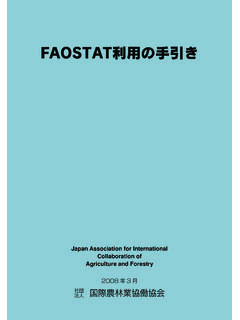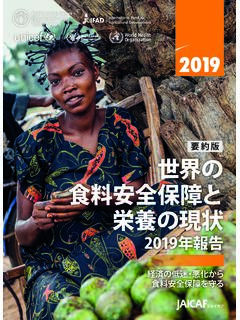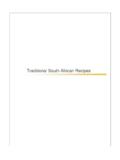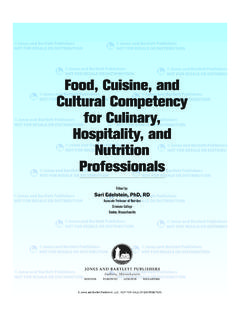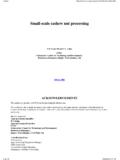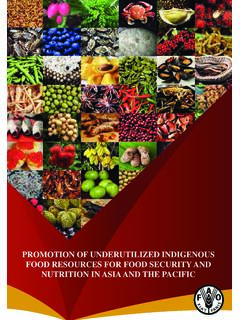Transcription of Study on Actual Situation of Medicinal Plants in …
1 Study on Actual Situation of Medicinal Plants in Ethiopia Prepared by Endashaw Bekele December, 2007. Prepared for JAICAF. (Japan Association for International Collaboration of Agriculture and Forestry). Table of Contents Executive ..1. 1. 2. Definition of " Medicinal Plants " in the project being ..15. 3. Contents of the ..16. 4. Overview of Medicinal plant Situation in Ethiopia .. 16. 5. Medicinal plant diversity and distribution in ..18. 6. The traditional medical system and Medicinal plant resources in 7. Current Government Policy on Medicinal Plants development goal ..22. 8. Accounts of the traditional Medicinal plant species of Ethiopia and its current Situation ..27. 9. Sources of supply of Medicinal Plants ..31. 10. Trade in Medicinal Plants .. 32. 11. Classification of Medicinal Plants and ailments treated ..35. 12. Sustainable Medicinal plant utilization and conservation . 36. 13. Overview of Medicinal plant industry, relevant experience to promote this sector in Ethiopia.
2 39. 14. International market of Medicinal 15. Future scenario of Medicinal plant in 41. a. Acquisition and transfer of indigenous knowledge on traditional b. Future prospects of traditional 16. Strength, Weakness and Opportunities (SWOT Analysis) in Medicinal plant a. 43. b. 43. c. 43. d. 17. Strategies for Improving the Role of Traditional Medicine and 18. Conclusion and 19. Cultivation and mode of production of some Medicinal , root, tuber, vegetables, Industrial crop, herbs and Reference Acronyms AAU Addis Ababa University BC Before Christ Ca About CIDA Canadian International Development Agency ESTC Ethiopian Science and Technology Commission ETB Ethiopian Birr IAR Institute of Agricultural Research IBCR Institute of Biodiversity and Conservation Research IFS International Foundation for Science IHN Institute of Health and Nutrition Study IUCN International Union for Conservation NGO Non-Governmental Organization MOH Ministry of Health RPO Research and Publication Office SAREC Swedish Agency for Research and Education SWOT Strength, Weakness, Opportunity and Threats Executive summary The Objectives of the present Study include relationship between human and Medicinal Plants in Ethiopia in terms of these Plants '.
3 Usage collection/production conservation and growth Situation constraints and potential The contents of the Study include: -- Current Situation and recent trends in Medicinal Plants ' sector development in Ethiopia. --Historical overview and recent trends regarding Medicinal Plants in Ethiopia. --Geographical overview of growth of Medicinal Plants in Ethiopia --Salient features of usage of Medicinal Plants in Ethiopia --Salient features of access to Medicinal Plants by Ethiopian people. --Differentiation of usage and access to Medicinal Plants according to various ethnic Groups -- Introduction of some specific Medicinal Plants where at least 1 herb, 1 spice in 5. Plants are included in terms of: -Conservation -Collection/ production -Distribution -Usage The cultivation and use of spices, herbs, Medicinal and other essential oil bearing Plants is not new to Ethiopia. It is as old as the crop themselves, and its history can be traced back to the reign of Queen Sheba ( BC).
4 Ethiopia is the origin and/or center of diversity for many of these plant species The various literature available show the significant role of Medicinal plant in primary health care delivery in Ethiopia where 70% of human and 90% of livestock population depend on traditional medicine similar to many developing countries particularly that of Sub-Saharan African countries. The traditional health care is culturally deep rooted 1. with oral and written pharmacopoeias. Ethiopian Plants have shown very effective Medicinal value for some ailments of human and domestic animals thus Medicinal Plants and knowledge of their use provide a vital contribution to human and livestock health care needs throughout the country. Such Plants include Phytolacca dodecandra and many species of Maytenus. The major reasons why Medicinal Plants are demanded in Ethiopia are due to culturally linked traditions, the trust the communities have in the Medicinal values of traditional medicine and relatively low cost in using them.
5 This is acknowledged for example by a result of recent Study that was conducted and showed that the value of both imported and domestically produced pharmaceutical products were about ETB billion. During the same year the value of Medicinal Plants including traded and non traded ones was ETB 423 million making average health coverage of 42% of Ethiopian expenditure on pharmaceutical products. This is not only a significant saving in terms of foreign currency but also availability assurance for the primary health care systems in the rural community. The volume of sales of Medicinal Plants has increased over years and this has been taken by some as the existence of disease prevalence requiring traditional Medicare causing increased demand which led to harvesting important Medicinal Plants . The expected increase in the cost of commercial drugs and their occasional impotency also increase demand of Medicinal Plants .
6 The proportion of consumers who rely on harvesting Medicinal plant is the highest in the rural area, since collecting from natural plantation is most accessible and cost affective. There are 6500 species of higher Plants in Ethiopia making the country one of the most diverse floristic regions in the world. There are large numbers of moderate to high value Medicinal Plants herbs and spices existing in the wild. However, of the existing Medicinal herbs and spice Plants only small % are traded. Being a land of diverse climatic and edaphic potentials, several of such indigenous and exotic species and essential oil bearing Plants could luxuriously grow in Ethiopia and provide remarkable benefits to the national economy. However, so far only two of the major 18. agro-ecological zones defined as hot to warm humid lowlands and Tepid to cool humid midlands carry out some research and production activities of some herbs, spices and related aromatic Plants .
7 2. The research made so far on Ethiopian Medicinal Plants has been mostly of producing inventories and checklists, some have been touched by modern research where their principal component has been analyzed and defined. The bulk of the plant matter used for Medicinal purposes is collected from natural vegetation stocks that are shrinking with degraded environment and is faced to substantial reduction or dwindling of species of Medicinal Plants . Different vegetation types that are found in the various agro ecological zones of Ethiopia accommodate various types of Medicinal Plants . The available reports show that the woodlands, the montane vegetation including grasslands and forests and the evergreen scrubs and rocky areas contain more Medicinal Plants with higher concentrations in the woodlands. These reports indicate that the microphylous vegetation of the wood lands contain more Medicinal Plants species followed by the montane grassland and riverine vegetation while the Afro alpine vegetation are the least of the group.
8 Ethiopian traditional life is painted with the hallmark of widespread use of traditional Medicinal Plants with various levels of sophistication within the indigenous Medicinal lore. It is blended with religious thinking and various beliefs and need further investigation. The basic categories of practitioners also are difficult to define. Some have described the traditional medical system of Ethiopia as medico-religious System (Dawit Abebe and Ahadu Ayehu, 1993) and others as Magical religious. Such description is due to close interaction of the Christian, Islamic and indigenous religions with the traditional medical system in the country which sometimes displays features related to magic, beliefs and faith in some areas. However, the enigmatic nature of the medical system does not make such relations clear in some parts of the country. Ethiopian peoples have their own set of written and or oral pharmacopoeias with the Medicinal use of some species being restricted to each ethnic group.
9 The cultural and indigenous knowledge of Medicinal Plants in Ethiopia is unevenly distributed among each community members. Peoples in different zones/location with different religious, linguistic and cultural backgrounds have their own specific knowledge about use of Plants which in part has gradually entered wide circulation in the country. The knowledge on Medicinal Plants is largely oral, however, Ethiopia's ancient church 3. practices have documented some of the knowledge as inscribed in Parchments which partly characterize the traditional medical system usually described as medico religious written in Geez manuscripts of the 15th century (Gelahun Abate, 1989; Dawit Abebe and Ahadu Ayehu, 1993). Other ancient written sources include the book of remedy (Metsehafe Fews) of the 17th century which contains a wide range of Medicinal Plants prescription (Fekadu Fullas, 2001). These are the medical traditions of the followers of Coptic Christianity.
10 Other cultural groups in the country have their own written or oral traditions that could be associated with individual clans or groups as partly stated by Amare Getahun (1976) and Abbink (1995). 1000 identified Medicinal plant species are reported in the Ethiopian Flora, however, many others are not yet identified. About 300 of these species are frequently mentioned in many sources. The greater concentration of Medicinal Plants are found in the south and south western Ethiopian parts of the country following the concentration of biological and cultural diversity (Edwards, 2001). The various citations made from various written records of Medicinal Plants from central, north and northwestern part of Ethiopia are thus small fractions of Medicinal Plants present in Ethiopia. Very recent Study on the Bale Mountains National Park in the South East Ethiopia revealed that the area, as much as it is a biodiversity hotspot, also turned out to be a Medicinal plant hotspot with 337 identified Medicinal species of which 24 are endemic (National Herbarium, 2004; Ermias Lulekal, 2005; Haile Yineger, 2005).


